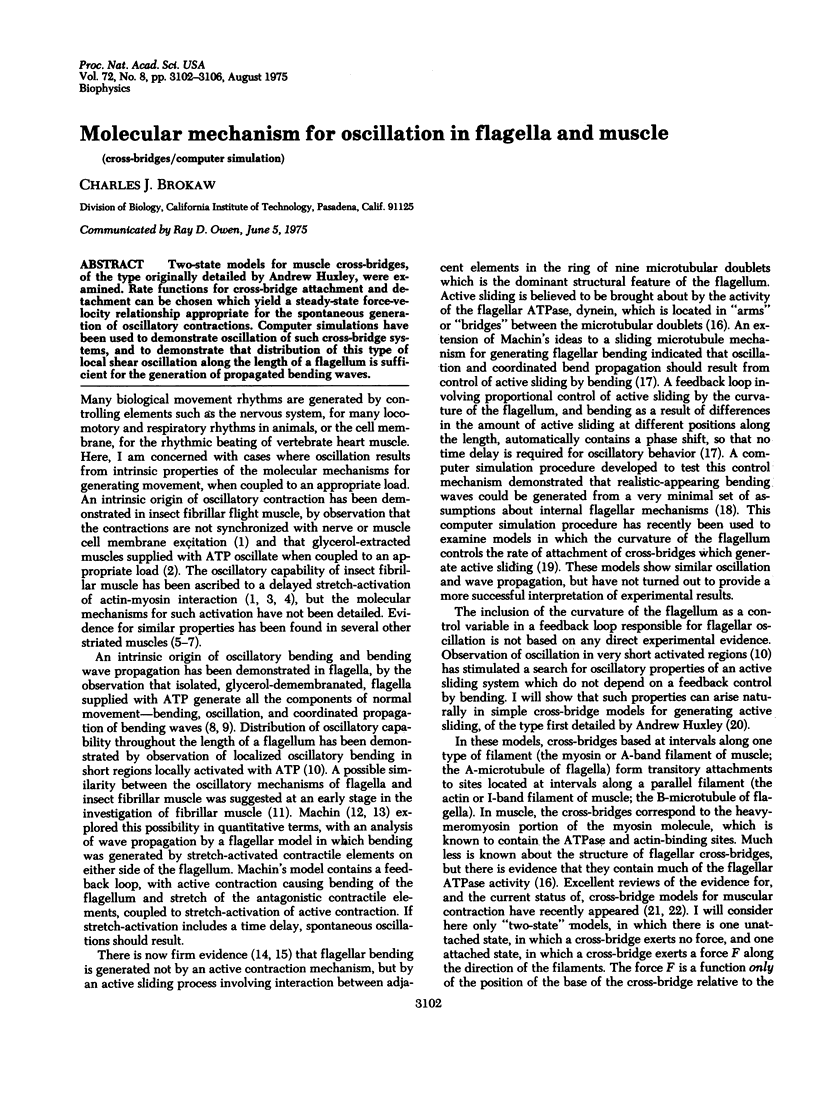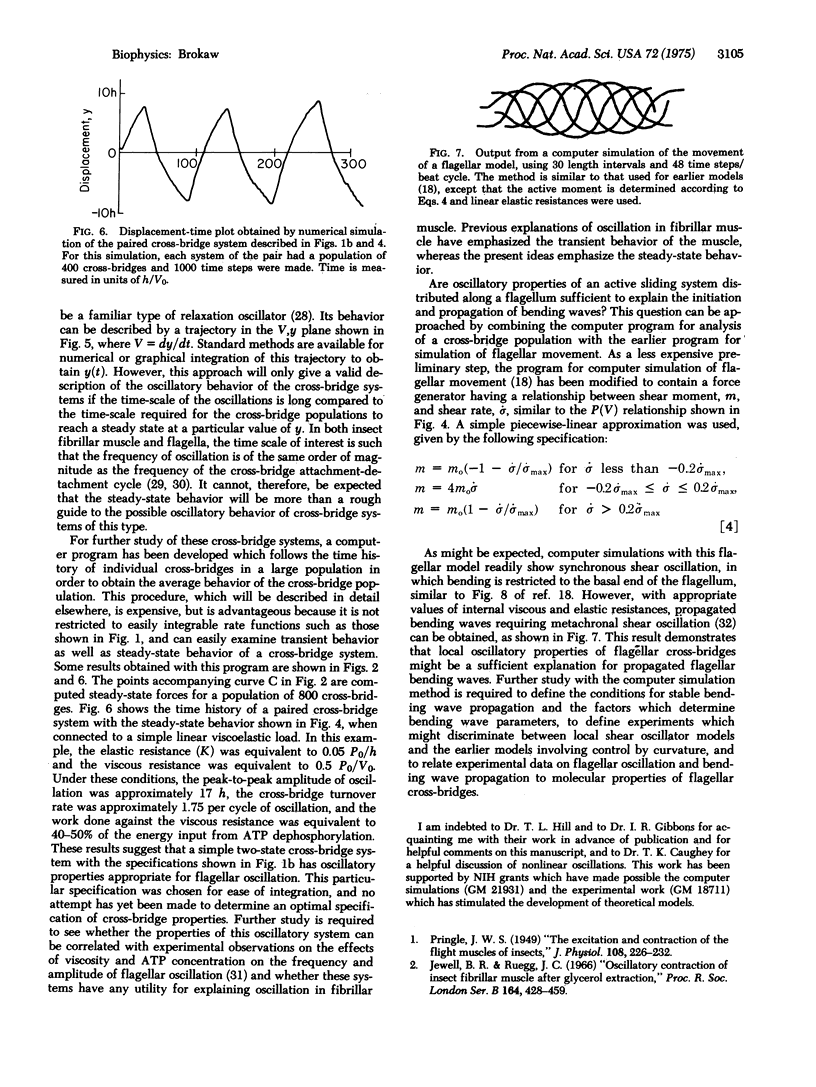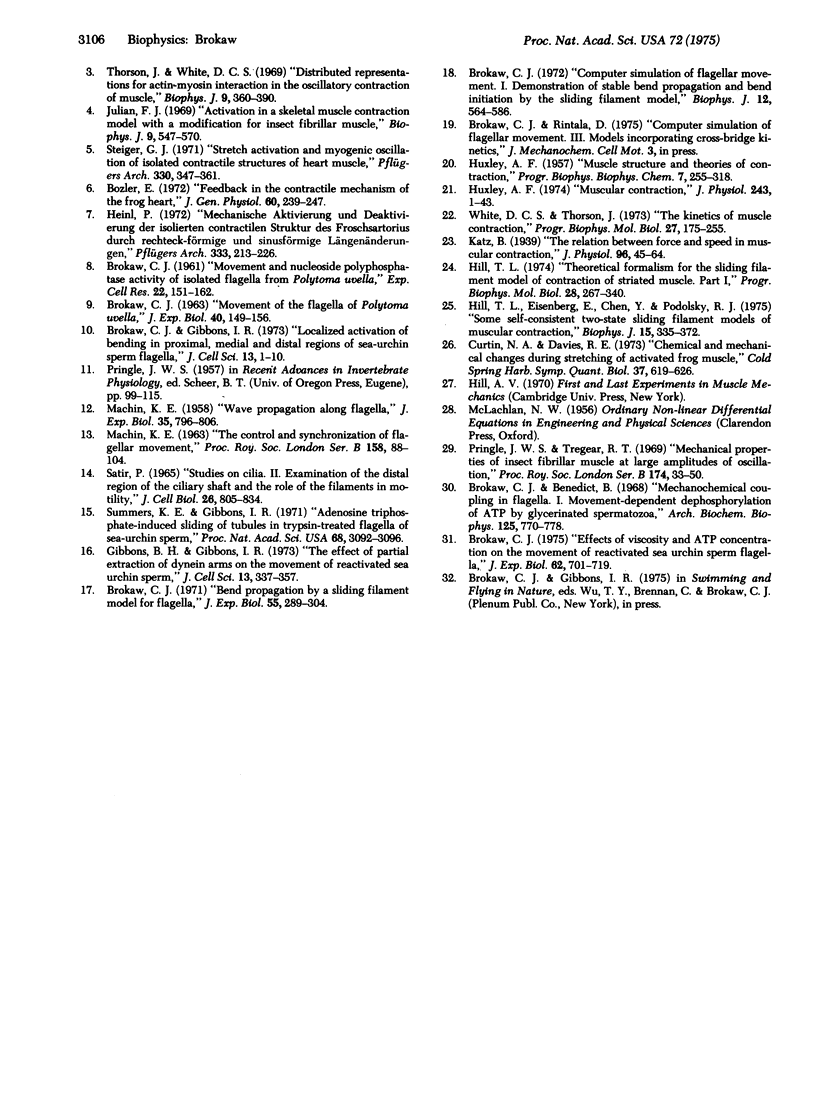Abstract
Two-state models for muscle cross-bridges, of the type originally detailed by Andrew Huxley, were examined. Rate functions for cross-bridge attachment and detachment can be chosen which yield a steady-state force-velocity relationship appropriate for the spontaneous generation of oscillatory contractions. Computer simulations have been used to demonstrate oscillation of such cross-bridge systems, and to demonstrate that distribution of this type of local shear oscillation along the length of a flagellum is sufficient for the generation of propagated bending waves.
Full text
PDF




Selected References
These references are in PubMed. This may not be the complete list of references from this article.
- Bozler E. Feedback in the contractile mechanism of the frog heart. J Gen Physiol. 1972 Sep;60(3):239–247. doi: 10.1085/jgp.60.3.239. [DOI] [PMC free article] [PubMed] [Google Scholar]
- Brokaw C. J. Bend propagation by a sliding filament model for flagella. J Exp Biol. 1971 Oct;55(2):289–304. doi: 10.1242/jeb.55.2.289. [DOI] [PubMed] [Google Scholar]
- Brokaw C. J., Benedict B. Mechanochemical coupling in flagella. I. Movement-dependent dephosphorylation of ATP by glycerinated spermatozoa. Arch Biochem Biophys. 1968 Jun;125(3):770–778. doi: 10.1016/0003-9861(68)90513-4. [DOI] [PubMed] [Google Scholar]
- Brokaw C. J. Computer simulation of flagellar movement. I. Demonstration of stable bend propagation and bend initiation by the sliding filament model. Biophys J. 1972 May;12(5):564–586. doi: 10.1016/S0006-3495(72)86104-6. [DOI] [PMC free article] [PubMed] [Google Scholar]
- Brokaw C. J. Effects of viscosity and ATP concentration on the movement of reactivated sea-urchin sperm flagella. J Exp Biol. 1975 Jun;62(3):701–719. doi: 10.1242/jeb.62.3.701. [DOI] [PubMed] [Google Scholar]
- Brokaw C. J., Gibbons I. R. Localized activation of bending in proximal, medial and distal regions of sea-urchin sperm flagella. J Cell Sci. 1973 Jul;13(1):1–10. doi: 10.1242/jcs.13.1.1. [DOI] [PubMed] [Google Scholar]
- Gibbons B. H., Gibbons I. R. The effect of partial extraction of dynein arms on the movement of reactivated sea-urchin sperm. J Cell Sci. 1973 Sep;13(2):337–357. doi: 10.1242/jcs.13.2.337. [DOI] [PubMed] [Google Scholar]
- HUXLEY A. F. Muscle structure and theories of contraction. Prog Biophys Biophys Chem. 1957;7:255–318. [PubMed] [Google Scholar]
- Heinl P. Mechanische aktivierung und Deaktivierung der isolierten contractilen Struktur des froschsartorius durch rechteckförmige und sinusförmige Längenänderungen. Pflugers Arch. 1972;333(3):213–226. doi: 10.1007/BF00592684. [DOI] [PubMed] [Google Scholar]
- Hill T. L., Eisenberg E., Chen Y. D., Podolsky R. J. Some self-consistent two-state sliding filament models of muscle contraction. Biophys J. 1975 Apr;15(4):335–372. doi: 10.1016/S0006-3495(75)85823-1. [DOI] [PMC free article] [PubMed] [Google Scholar]
- Hill T. L. Theoretical formalism for the sliding filament model of contraction of striated muscle. Part I. Prog Biophys Mol Biol. 1974;28:267–340. doi: 10.1016/0079-6107(74)90020-0. [DOI] [PubMed] [Google Scholar]
- Huxley A. F. Muscular contraction. J Physiol. 1974 Nov;243(1):1–43. [PMC free article] [PubMed] [Google Scholar]
- Julian F. J. Activation in a skeletal muscle contraction model with a modification for insect fibrillar muscle. Biophys J. 1969 Apr;9(4):547–570. doi: 10.1016/S0006-3495(69)86403-9. [DOI] [PMC free article] [PubMed] [Google Scholar]
- Katz B. The relation between force and speed in muscular contraction. J Physiol. 1939 Jun 14;96(1):45–64. doi: 10.1113/jphysiol.1939.sp003756. [DOI] [PMC free article] [PubMed] [Google Scholar]
- Pringle J. W., Tregear R. T. Mechanical properties of insect fibrillar muscle at large amplitudes of oscillation. Proc R Soc Lond B Biol Sci. 1969 Oct 7;174(1034):33–50. doi: 10.1098/rspb.1969.0079. [DOI] [PubMed] [Google Scholar]
- Satir P. STUDIES ON CILIA : II. Examination of the Distal Region of the Ciliary Shaft and the Role of the Filaments in Motility. J Cell Biol. 1965 Sep 1;26(3):805–834. doi: 10.1083/jcb.26.3.805. [DOI] [PMC free article] [PubMed] [Google Scholar]
- Steiger G. J. Stretch activation and myogenic oscillation of isolated contractile structures of heart muscle. Pflugers Arch. 1971;330(4):347–361. doi: 10.1007/BF00588586. [DOI] [PubMed] [Google Scholar]
- Summers K. E., Gibbons I. R. Adenosine triphosphate-induced sliding of tubules in trypsin-treated flagella of sea-urchin sperm. Proc Natl Acad Sci U S A. 1971 Dec;68(12):3092–3096. doi: 10.1073/pnas.68.12.3092. [DOI] [PMC free article] [PubMed] [Google Scholar]
- Thorson J., White D. C. Distributed representations for actin-myosin interaction in the oscillatory contraction of muscle. Biophys J. 1969 Mar;9(3):360–390. doi: 10.1016/S0006-3495(69)86392-7. [DOI] [PMC free article] [PubMed] [Google Scholar]


